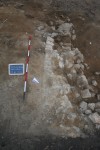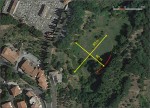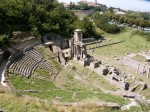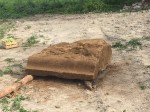 Last July, workers on a waterway restoration project near the Diana Gate on the north side of the ancient Etruscan city of Volterra stumbled on the remains of two walls 20 meters (66 feet) long. Archaeologists from the regional Superintendency were observing the works and took over when the ancient walls were found. Extrapolating from the shape and direction of the structures already unearthed, they dug test trenches in two locations that would have more walls if the building were, as they suspected, an amphitheater. Lo and behold, they found exactly what they expected to find: two more masonry walls each ten meters long with a marked elliptical curve.
Last July, workers on a waterway restoration project near the Diana Gate on the north side of the ancient Etruscan city of Volterra stumbled on the remains of two walls 20 meters (66 feet) long. Archaeologists from the regional Superintendency were observing the works and took over when the ancient walls were found. Extrapolating from the shape and direction of the structures already unearthed, they dug test trenches in two locations that would have more walls if the building were, as they suspected, an amphitheater. Lo and behold, they found exactly what they expected to find: two more masonry walls each ten meters long with a marked elliptical curve.
 Calculating from the established curvature, the building is an oval 80 meters (262 feet) long by 60 meters (197 feet) wide, which is a pretty massive structure for people to forget ever existed. Volterra already has one Roman theater from the late 1st century BC, early 1st century AD that was discovered in 1950 by Volterran native son and historian Enrico Fiumi who was actually a trained economist, not an archaeologist, and whose excavation team was composed of patients from a local psychiatric hospital. The theater was partly dug into the side of a hill in Greek fashion and seated 3500. Some of the seats were found with the names of the most prominent local families, season ticket holders, if you will. A large section of the two-level skene (the building behind the stage) 50 feet high survives.
Calculating from the established curvature, the building is an oval 80 meters (262 feet) long by 60 meters (197 feet) wide, which is a pretty massive structure for people to forget ever existed. Volterra already has one Roman theater from the late 1st century BC, early 1st century AD that was discovered in 1950 by Volterran native son and historian Enrico Fiumi who was actually a trained economist, not an archaeologist, and whose excavation team was composed of patients from a local psychiatric hospital. The theater was partly dug into the side of a hill in Greek fashion and seated 3500. Some of the seats were found with the names of the most prominent local families, season ticket holders, if you will. A large section of the two-level skene (the building behind the stage) 50 feet high survives.
 There is some mention in 15th and 16th century sources of an amphitheater in Volterra, but the writers were considered less than reliable on the details and thought to have been referring to the theater Fiumi discovered rather than a real amphitheater.
There is some mention in 15th and 16th century sources of an amphitheater in Volterra, but the writers were considered less than reliable on the details and thought to have been referring to the theater Fiumi discovered rather than a real amphitheater.
The discovery of the amphitheater caused a stir, but there was no funding to continue digging. The city had to go begging hat in hand to the local bank for sponsorship which thankfully they were able to secure. This September excavations resumed. Archaeologists found two rows of steps and additional architectural features were discovered: a large carved block that was part of the cryptoporticus roof and the base of an entrance arch. Like the ancient Etruscan city walls, these  features are made of a porous sandstone native to the area called panchina which is soft and easy to work but hardens when exposed to the air.
features are made of a porous sandstone native to the area called panchina which is soft and easy to work but hardens when exposed to the air.
“This amphitheater was quite large. Our survey dig revealed three orders of seats that could accommodate about 10,000 people. They were entertained by gladiators fights and wild beast baiting,” Elena Sorge, the archaeologist of the Tuscan Superintendency in charge of the excavation, told Discovery News.
By comparison, the Colosseum in Rome could seat more than 50,000 spectators during public games.
“The finding sheds a new light on the history of Volterra, which is most famous for its Etruscan legacy. It shows that during the emperor Augustus’s rule, it was an important Roman center,” she added.
 Tuscany’s oldest continuously inhabited town, Volterra was an important urban center from the 6th century B.C. through the Renaissance, falling under the Roman sphere of influence in the 3rd century B.C. and under direct Roman control in the 1st century BC. Although there’s never been any doubt that it retained its cultural and political significance in the imperial era, the discovery of a second much larger public entertainment complex possibly from the 1st century A.D. indicates the city was more prominent and more populated than historians realized.
Tuscany’s oldest continuously inhabited town, Volterra was an important urban center from the 6th century B.C. through the Renaissance, falling under the Roman sphere of influence in the 3rd century B.C. and under direct Roman control in the 1st century BC. Although there’s never been any doubt that it retained its cultural and political significance in the imperial era, the discovery of a second much larger public entertainment complex possibly from the 1st century A.D. indicates the city was more prominent and more populated than historians realized.
The goal of this fall’s excavation was very limited: analyze the remains to get a solid idea of what else is out there. With more data to work with, the archaeological team will be able to design a plan for a more thorough future excavation and a budget. Then they’ll have some figures to use when scrambling for more funding.